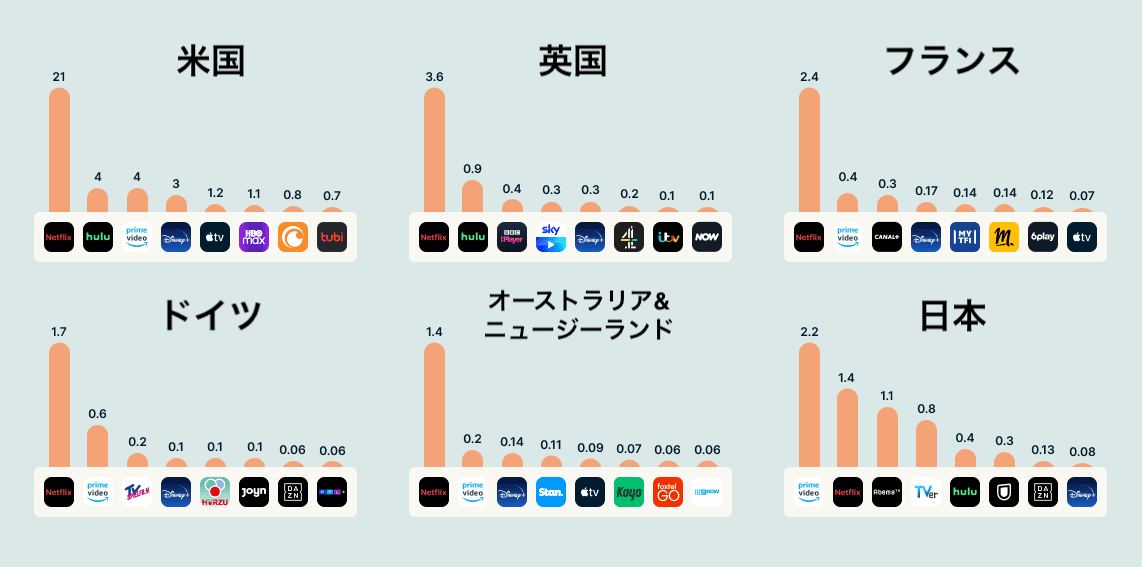
[evpn_canva id="DAFQ4eSfQkk"]
※画面をクリックするとスライドを動かせます
2022年もAmazonプライム・ビデオやNetflixなどの動画配信サービスからさまざまな注目コンテンツが配信されました。作品が多すぎて、どれを見るべきか迷う人も多いでしょう。そこでExpressVPNでは、今年日本で人気だったコンテンツ※を月別にスライドでまとめました。人気作品を知りたい方、視聴を逃した方、もう一度見る作品を選びたい方は、ぜひ参考にしてください。(※視聴ランキングの結果はマーケティング調査事業を行うGEM Partners株式会社の2022年の調査結果に基づきます)
また、各動画配信サービスの傾向についても下の記事にまとめています。スライドでご紹介しきれなかった人気作品をたくさん紹介していますので、こちらもぜひ目を通してみてください。
ストリーミングの味方、ExpressVPNは、各動画配信サービスに対応したVPNアプリをご用意しています。VPNはユーザーのネットワークを暗号化で保護するだけでなく、インターネットサービスプロバイダ(ISP)に回線を速度調整されないよう、快適なストリーミング環境をサポートします。VPNを使って、コンテンツを最大限に楽しみましょう!
目次
世界ではNetflix、日本ではAmazonプライムが人気
アニメが視聴ランキングの上位を独占!
Netflixでは韓国ドラマに人気が集中
Amazonプライムには強力な「指輪の力」
コンテンツ&ファン拡大中のディズニープラス
VPNを使ってストリーミングを楽しもう!
世界ではNetflix、日本ではAmazonプライムが人気
2021年のメディア・パートナーズ・アジアの調査で、日本の有料動画配信サービスでは、Amazonプライム・ビデオが約33%を占めていることがわかりました。また、同時期に発表されたAppleの調査でもiPhoneユーザーが利用したサービスはAmazonプライム・ビデオが断トツで多く、日本は特徴的な傾向にあると言えます。(画像参照元:出典:https://www.apple.com/newsroom/pdfs/the-success-of-third-party-apps-on-the-app-store.pdf)
アニメが視聴ランキングの上位を独占!
映画、ドラマ、配信サービスオリジナル作品など、世界的に話題の作品が次々リリースされた中、日本ではアニメが不動の地位を確立していることがわかりました。
『鬼滅の刃』は、2021年の10月から2022年3月まで総合1位を独占し、圧倒的な人気を見せつけました。今年1月においては、サービス別でも、ディズニープラスを除く、Amazonプライム・ビデオ、Netflix、U-NEXT、Hulu、dアニメストア、dTVで1位を獲得。映画やテレビシリーズの相乗効果で幅広いファンを獲得したと言えるでしょう。
新作アニメで今年のランキング上位に登場したのは、『SPY×FAMILY』です。4月に総合2位でスタートしたものの、5月から7月まで総合1位、10月にもアニメの新シリーズが配信開始で総合1位になり、『名探偵コナン』や『ワンピース』と肩を並べる、人気アニメの一つになりました。また、『キングダム』も5月から7月、9月にそれぞれ総合3位、8月には総合2位に入り、根強い視聴者層がいることがうかがえました。
Netflixでは韓国ドラマに人気が集中
アニメ人気は疑いようのない事実ですが、日本で視聴されているコンテンツといえば、韓国映画やドラマを抜きには語れないでしょう。調査されたランキングでは、年間を通じてNetflixオリジナルとなる韓国作品が複数、月刊ランキングの総合20位以内に含まれていました。
2021年9月17日から配信され、Netflix史上最大人気のコンテンツとなった『イカゲーム』は、2022年に入っても人気を保ち、1月においては韓国ドラマの中で最も視聴されたコンテンツでした(総合7位)。この他、韓国のゾンビドラマの『今、私たちの学校は...』(2月の韓国ドラマ1位 - 総合8位)、『39歳』(3月、4月の韓国ドラマ1位 - 総合8位、15位)、『ウ・ヨンウ弁護士は天才肌』(7月、8月、9月の韓国ドラマ1位 - 総合19位、15位、15位)が上位だったほか、長期的に人気の『愛の不時着』、新作の『気象庁の人々』が2月から4月にかけて総合20位以内にランクインしました。
Netflixといえば、10年ぶりに登録者が減ったことで話題になりましたが、今年の注目作品の一つは『ストレンジャー・シングス』のシーズン4です。米国では英語コンテンツとしてはNetflix史上最高のオープニング視聴成績を達成、日本でも5月のリリース以降、6月と7月のNetflixコンテンツとしては第1位でした(総合14位、10位)。この作品があまりに人気で、Netflixは失った登録者以上の新規登録者を回復できたと言われています。
Amazonプライムには強力な「指輪の力」
日本のメジャーな動画配信サービスであるAmazonプライム・ビデオは、人気アニメシリーズの独占配信見放題などで、アニメ全体の視聴者の伸びに大きく貢献してると言えます。
日本のアニメファンを魅了する一方で、Amazonプライム・ビデオは独自コンテンツに莫大な予算をかけたことが、世界的に話題になりました。715百万ドル(日本円で1,050億円)を費やしたその作品は、『ロード・オブ・ザ・リング:力の指輪』です。新作の1話と2話の配信では、2,500万人が配信当日に視聴するというAmazonプライム・ビデオ史上最高の視聴数を獲得しました。日本でも9月の総合2位に入り、アニメ以外のコンテンツとして今年初めてトップ3入りを果たしたコンテンツとなりました(ドキュメンタリーを除く)。
この他、『ザ・ボーイズ』(6月の総合9位)や洋画『ムーンフォール』(8月の総合5位)、バラエティ『ザ・マスクド・シンガー』(8月の総合6位)、恋愛リアリティーショー『バチェロレッテ・ジャパン』のシーズン2(7月の総合4位)も、総合10位以内にランクインしたAmazonプライム・ビデオの人気コンテンツでした。
コンテンツ&ファン拡大中のディズニープラス
ディズニープラス(Disney+)は、日本で2020年6月からサービスを開始したディズニー、ピクサー、マーベル、スター・ウォーズ、ナショナルジオグラフィックのコンテンツが視聴できるサービスです。日本の今年の総合ランキングで最も上位にランクインしたのは『オビ=ワン・ケノービ』(6月の総合13位)でした。
ディズニープラス単体としては、スターウォーズの人気キャラクターを描いた『ボバ・フェット』(1月と2月のディズニープラス1位)マーベルドラマ『ムーンナイト』(4月と5月のディズニープラス1位)、マーベルのスーパーヒロイン『シー・ハルク:ザ・アトーニー』(8月と9月のディズニープラス1位)が人気作品となりました。
ディズニープラスは今年、会員数が4~6月に1440万人増え、6月末時点で1億5210万人に達したと発表しました。Netflixよりも割安な価格と独自コンテンツの拡大で、日本でも会員数が大きく伸びてくるかもしれません。
VPNを使ってストリーミングを楽しもう!
今年も残りわずか、見切れなかったコンテンツを年末年始にぜひじっくり視聴してみてはいかがでしょうか。ストリーミングの際にはVPNの使用をお忘れなく!
EXPRESSVPNは、著作権回避手段として使用することを目的としないVPNサービスです。詳細は、EXPRESSVPNおよびご利用のコンテンツプロバイダの利用規約をお読みください。
Take the first step to protect yourself online. Try ExpressVPN risk-free.
Get ExpressVPN




